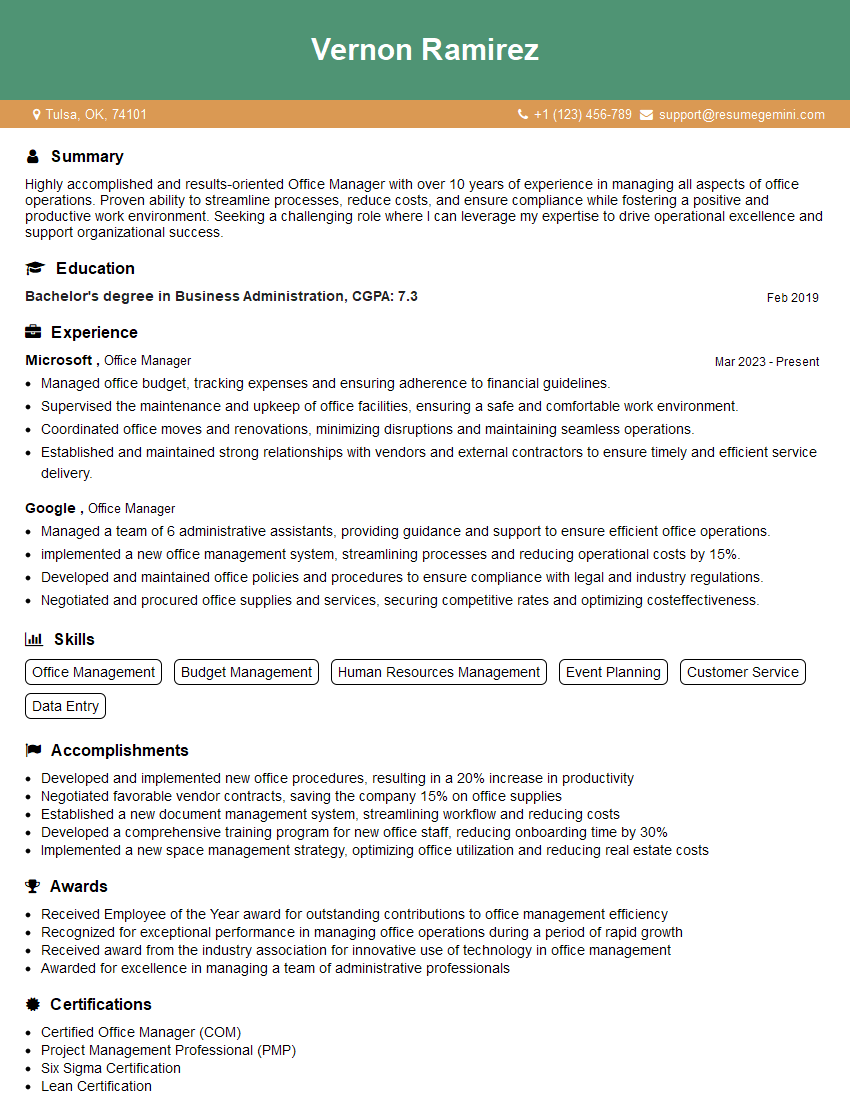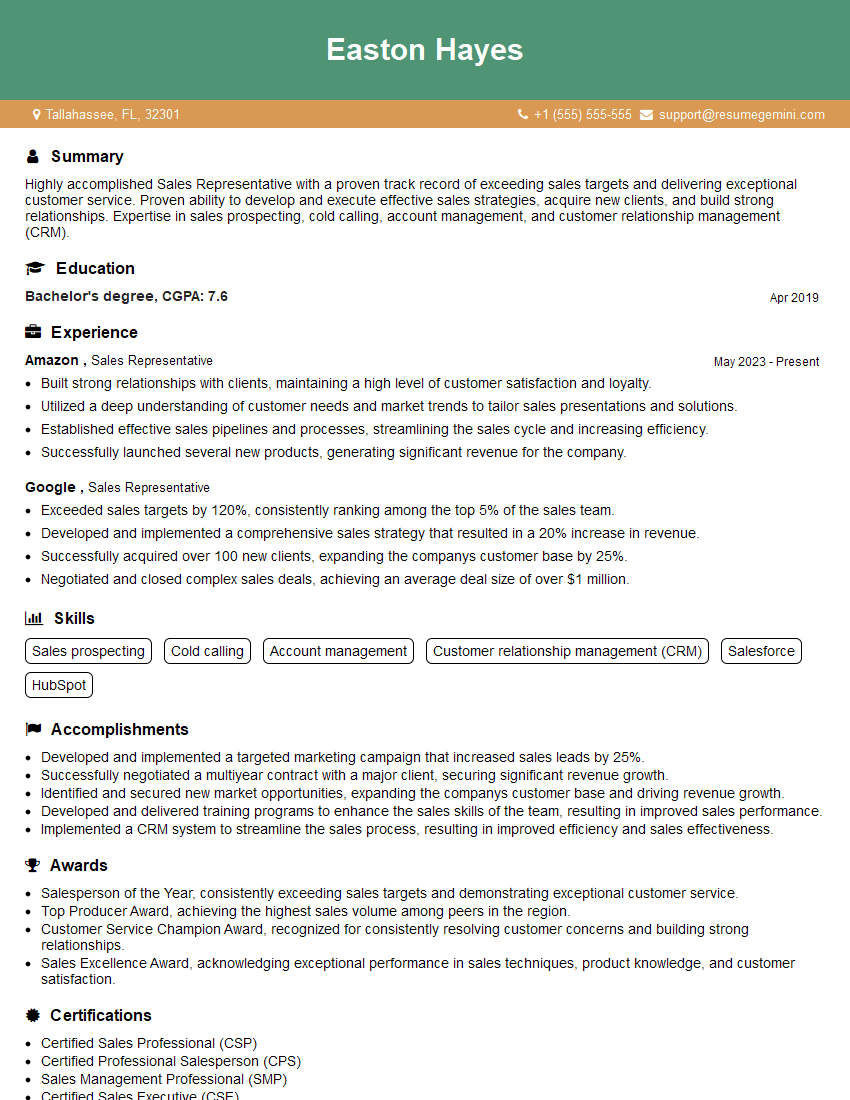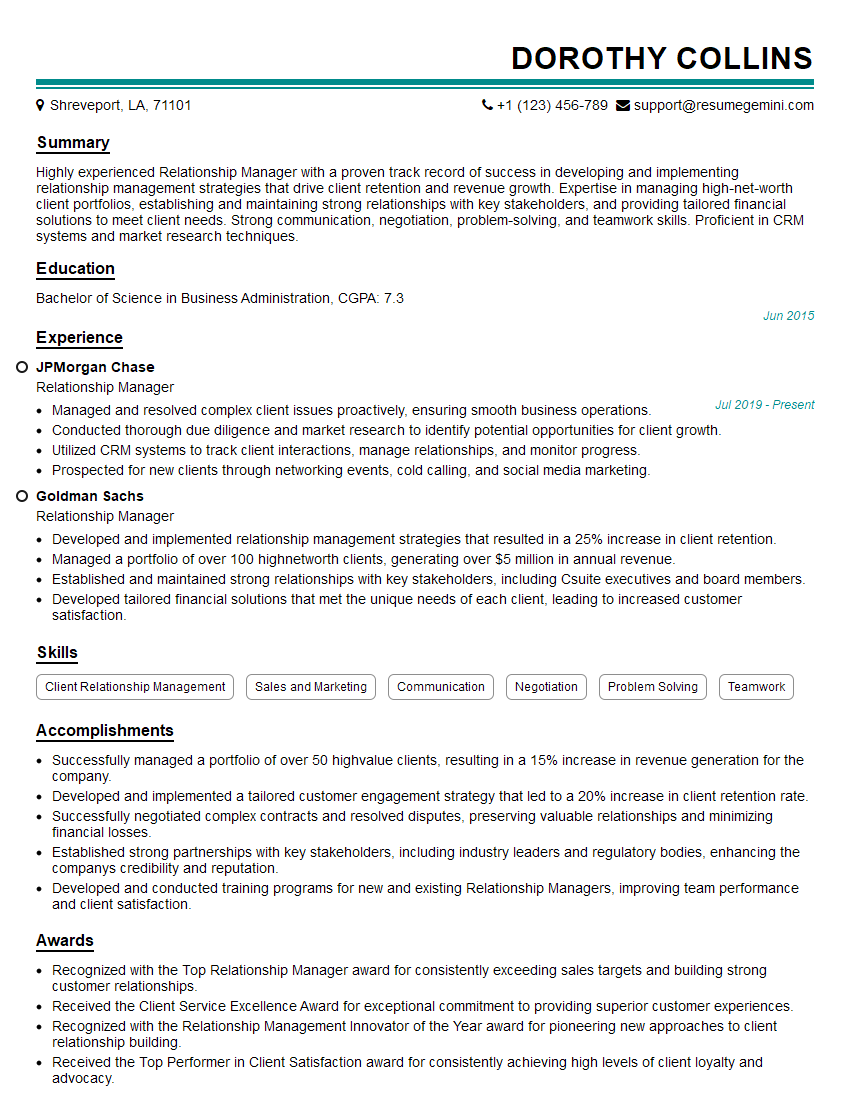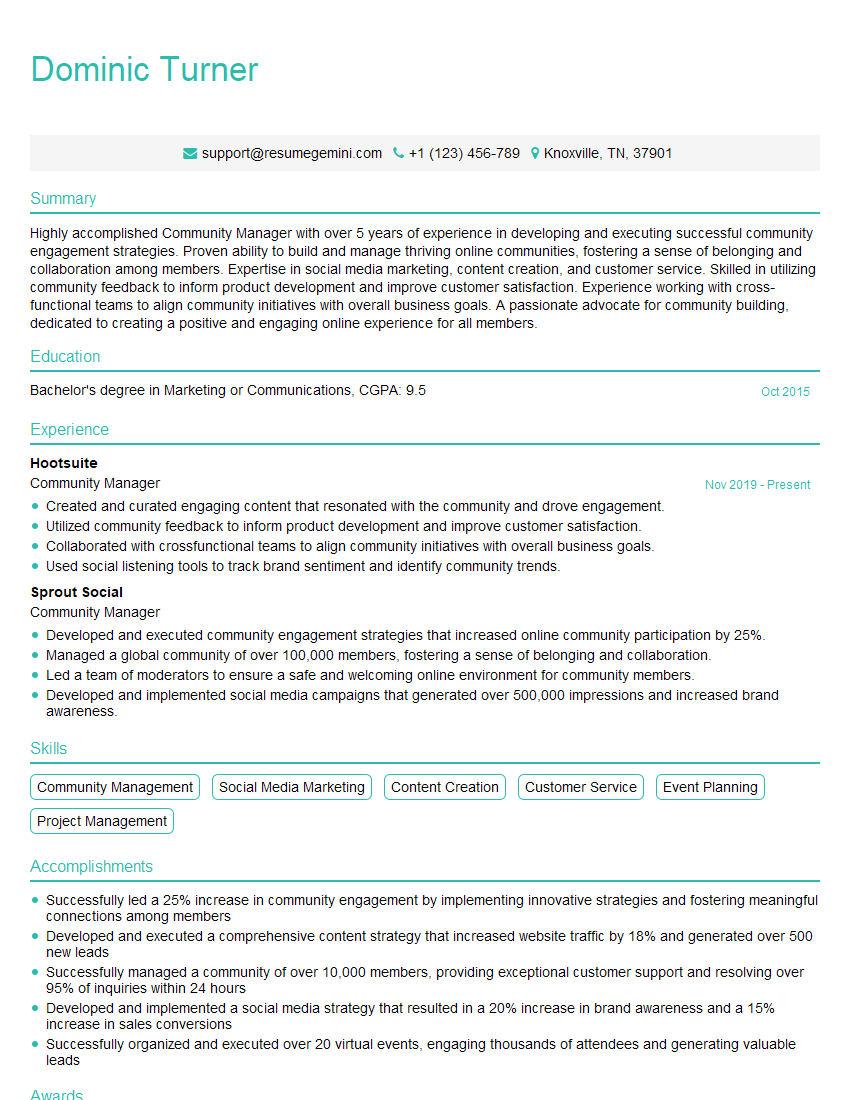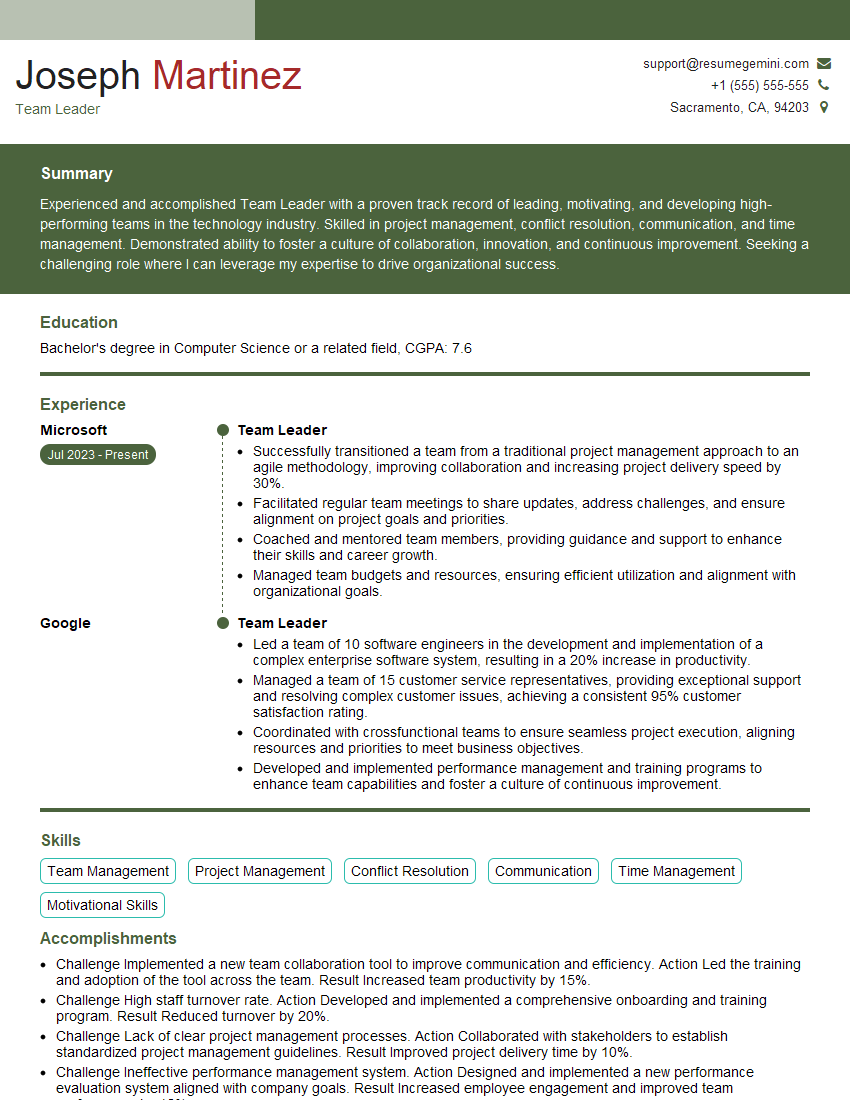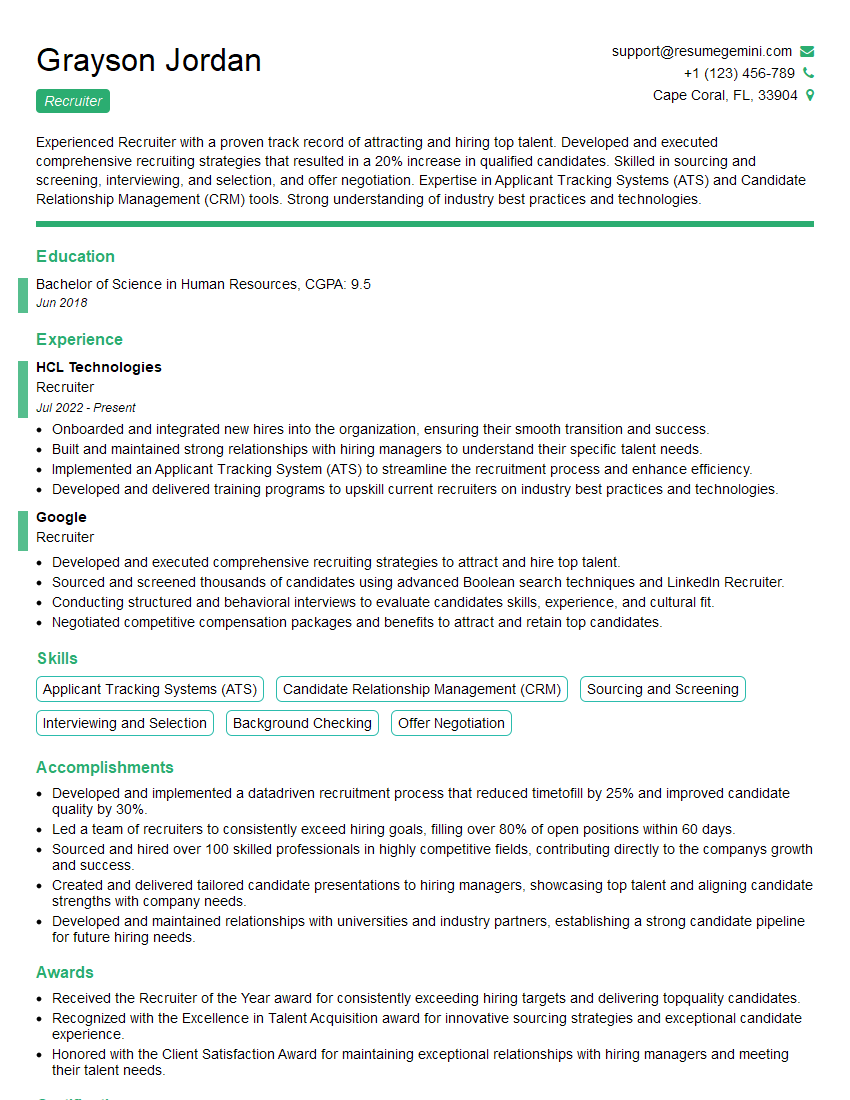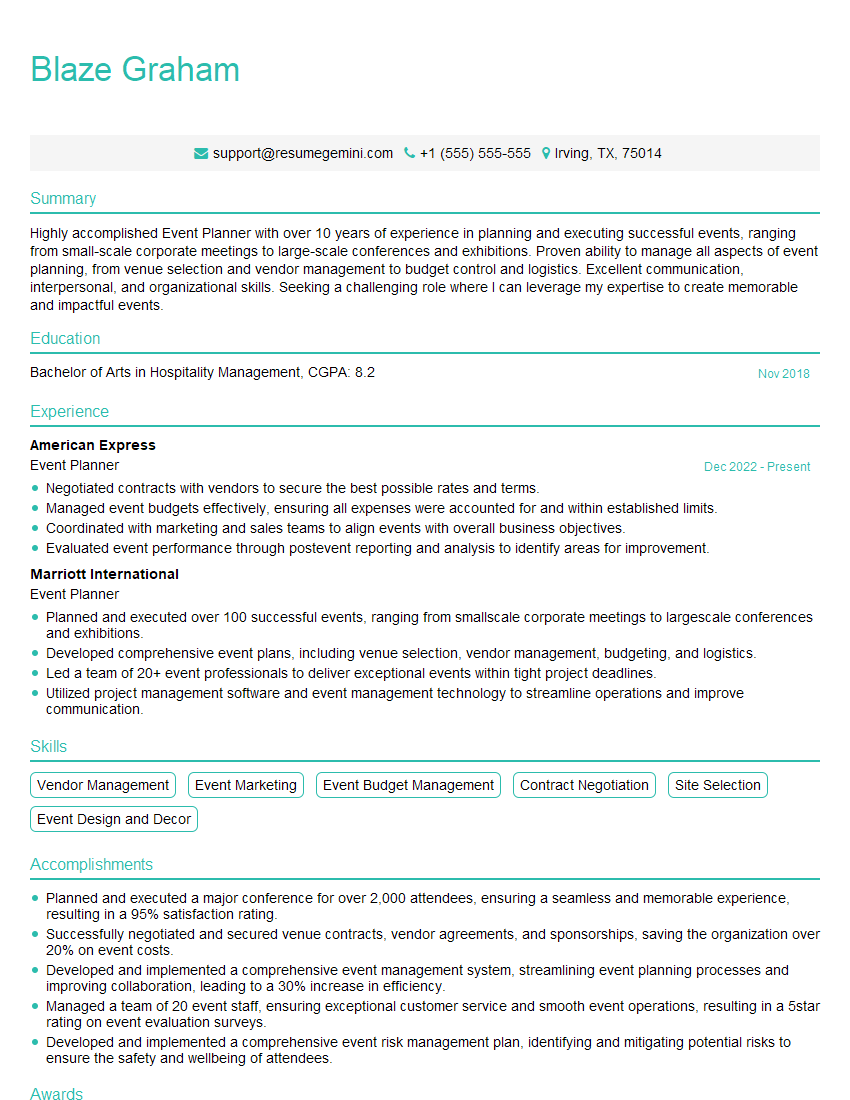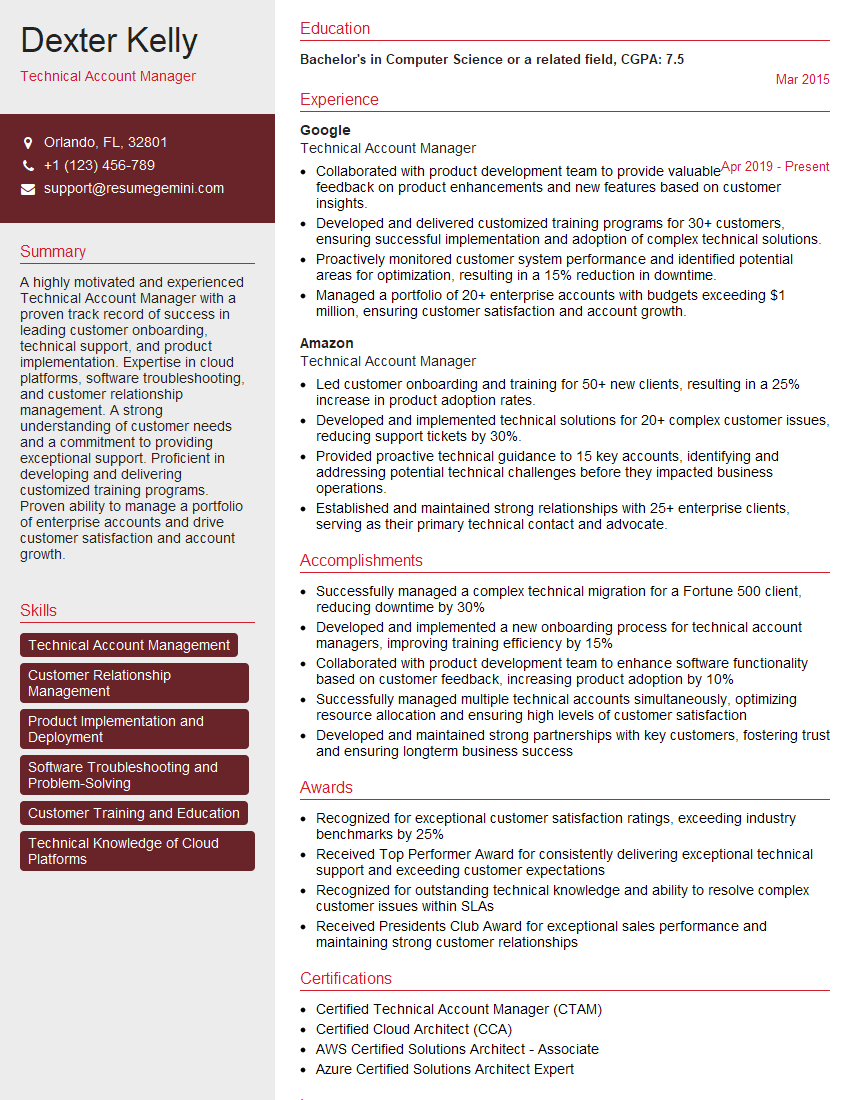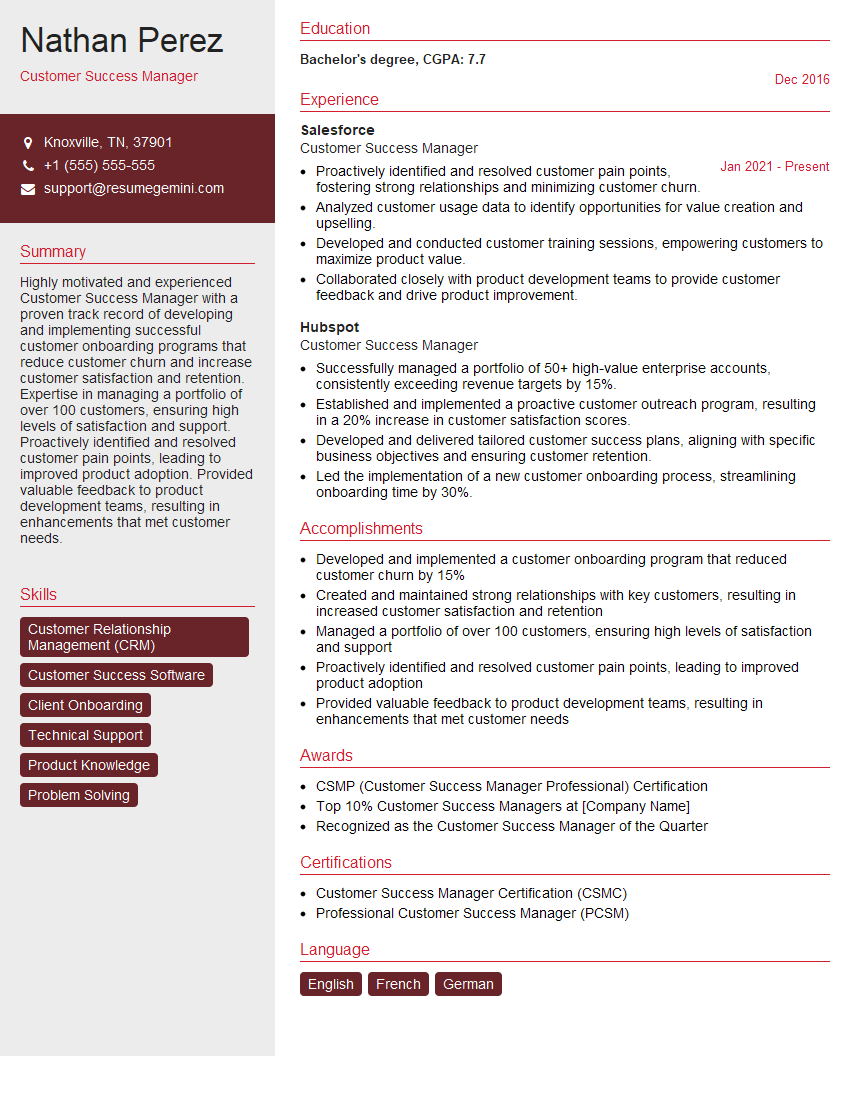Interviews are more than just a Q&A session—they’re a chance to prove your worth. This blog dives into essential Strong networking and interpersonal skills. interview questions and expert tips to help you align your answers with what hiring managers are looking for. Start preparing to shine!
Questions Asked in Strong networking and interpersonal skills. Interview
Q 1. Describe a time you successfully navigated a conflict with a colleague.
Conflict is inevitable in any collaborative environment. My approach focuses on open communication and collaborative problem-solving. For example, I once had a disagreement with a colleague regarding the best approach for a software deployment. Initially, we both strongly defended our positions, leading to a somewhat tense discussion. Instead of escalating, I suggested a collaborative brainstorming session. We outlined the pros and cons of each approach, considered alternative solutions, and ultimately agreed on a hybrid approach that incorporated the strengths of both our initial ideas. This resulted not only in a successful deployment but also a strengthened working relationship. The key was active listening, empathy, and a willingness to compromise. We identified the root of the conflict—a difference in understanding project risk—and worked together to find a mutually agreeable solution. The outcome reinforced the importance of clear communication and respect for differing perspectives.
Q 2. How do you build rapport with individuals from diverse backgrounds?
Building rapport with diverse individuals involves genuine curiosity and a conscious effort to understand different perspectives. I begin by actively listening to their experiences and viewpoints, showing genuine interest in their backgrounds and cultural norms. I avoid making assumptions and instead ask open-ended questions to understand their communication styles and preferences. For instance, when working with international teams, I am mindful of time zone differences and cultural communication styles, adapting my approach accordingly. In one project with a global team, I took the time to learn a few basic phrases in the native languages of my colleagues, which was appreciated and helped build trust. Furthermore, I strive to create a safe and inclusive environment where everyone feels comfortable sharing their ideas, regardless of their background. The goal is to foster mutual respect and understanding, recognizing that our differences are strengths, not weaknesses.
Q 3. Explain your approach to networking in a professional setting.
My approach to professional networking is strategic and relationship-focused. It’s not about collecting business cards; it’s about building genuine connections. I attend industry events, conferences, and workshops, actively engaging in conversations and seeking opportunities to learn from others. I actively participate in online professional communities, sharing insights and contributing to discussions. I follow up on initial interactions with personalized emails, highlighting something specific we discussed to show that I value the connection. I also actively seek out mentors and individuals whose expertise I admire, requesting informational interviews to learn from their experience. Building and nurturing these relationships is an ongoing process, requiring consistent effort and genuine interest in others’ success. It’s about reciprocity; offering support and assistance to others whenever possible.
Q 4. How do you handle a situation where a colleague is not meeting expectations?
Addressing a colleague’s underperformance requires a sensitive yet direct approach. I’d start by having a private conversation, focusing on specific instances of unmet expectations, using concrete examples rather than vague criticisms. I’d create a safe space for open dialogue, allowing them to express their perspective and any challenges they might be facing. Together, we would collaboratively identify the root causes of the performance issues, whether it’s lack of training, insufficient resources, or personal issues. We would then develop a performance improvement plan (PIP) with clear, measurable goals, timelines, and support systems. Regular check-ins would be crucial to monitor progress and offer ongoing guidance and support. If the situation doesn’t improve despite these interventions, I would escalate the matter to the appropriate management channels, ensuring fairness and consistency with company policies.
Q 5. Describe a time you had to influence a group to achieve a common goal.
Influencing a group requires understanding individual motivations and aligning them with the common goal. In one project, our team was facing a tight deadline and disagreements arose on the best strategy. I facilitated a series of workshops where each team member could present their ideas, using visual aids and encouraging collaborative brainstorming. I actively listened to all perspectives, acknowledging the value of each contribution. I then synthesized these ideas, highlighting the areas of common ground and addressing the concerns raised. By framing the common goal—successful project completion—in a positive and achievable manner, I motivated the team to work together. This collaborative approach resulted in a shared vision, eliminating conflicting opinions and boosting team morale. The project was completed successfully and on time, demonstrating the power of collaborative influence.
Q 6. How do you prioritize competing demands on your time and attention?
Prioritizing competing demands involves a structured approach. I use a combination of techniques, including task prioritization matrices (like Eisenhower Matrix) to categorize tasks based on urgency and importance. I also leverage time management techniques like time blocking, allocating specific time slots for crucial tasks. Regularly reviewing my to-do list and adjusting priorities based on changing circumstances is essential. Delegation is also crucial; I’m comfortable assigning tasks to others when appropriate, maximizing team efficiency. Finally, I practice mindful self-care to avoid burnout, ensuring I have sufficient time for rest and rejuvenation. This holistic approach ensures that I’m effectively managing my time and energy, prioritizing tasks that align with strategic goals and avoiding information overload.
Q 7. How do you maintain professional relationships with clients or colleagues?
Maintaining professional relationships requires consistent effort and genuine care. Regular communication, even if just brief check-ins, is crucial. I actively listen to their needs and concerns, offering support whenever possible. Celebrating successes together, whether personal or professional, strengthens bonds. I also make an effort to remember important details about their lives and professional goals, showing that I value our relationships. Addressing disagreements professionally and respectfully is important; maintaining open communication ensures that any issues are resolved quickly and effectively. Building trust and mutual respect through consistent positive interactions is the cornerstone of strong, lasting professional relationships.
Q 8. Describe a time you had to negotiate a favorable outcome.
Negotiation is a crucial skill, especially in a networking environment. It’s about finding a mutually beneficial solution, not just winning. A successful negotiation requires understanding the other party’s needs and priorities as much as your own.
In my previous role at Acme Corp, we were tasked with integrating a new software system with our existing infrastructure. The vendor initially proposed a price that was significantly above budget. Instead of immediately rejecting their offer, I initiated a conversation, focusing on the value they brought and the challenges of integration. I highlighted the potential long-term benefits of their system – increased efficiency and cost savings in the long run – to justify a higher price. I also explored different pricing models, suggesting a phased implementation with payments tied to milestones. This approach allowed us to secure a more favorable contract, reducing the initial cost and aligning it with our budgetary constraints, while also ensuring the vendor remained motivated to deliver a successful integration.
Q 9. How do you handle constructive criticism?
Constructive criticism is invaluable for growth. I view it as an opportunity for improvement and learning. My approach is to actively listen, ask clarifying questions, and avoid getting defensive. I focus on understanding the feedback, separating the criticism from the person delivering it.
For instance, if someone points out a flaw in my presentation, instead of arguing, I’ll ask for specific examples or suggestions on how to improve. This demonstrates my willingness to learn and adapt. Then, I incorporate that feedback to refine my approach. I believe that this open and receptive attitude ultimately builds stronger professional relationships based on mutual respect and continuous learning.
Q 10. Explain your experience working on a team project.
Teamwork is fundamental to success in any complex project. My experience in team projects involves actively participating in all phases, from brainstorming to implementation and evaluation. I believe in transparent communication, clear role definition, and collaborative problem-solving.
In one project, we had to develop a marketing campaign for a new product launch. Our team comprised individuals with diverse skill sets—marketing, design, and development. I took the initiative to establish a shared online project management system, ensuring consistent updates and clear communication channels. We utilized daily stand-up meetings to discuss progress and address roadblocks promptly. Each member was responsible for specific tasks, but we all collaborated on critical decisions. This collaborative approach enabled us to launch the campaign successfully, exceeding our initial targets.
Q 11. Describe your approach to problem-solving in a collaborative environment.
My approach to problem-solving in a collaborative environment starts with clearly defining the problem. This often involves brainstorming sessions where everyone gets a chance to contribute. Once the problem is well-defined, I utilize a structured approach, breaking down the problem into smaller, manageable tasks. Then, we assign roles and responsibilities, ensuring that everyone understands their contribution. Throughout the process, open communication is key. We use tools like Kanban boards or agile methodologies to track progress, identify potential bottlenecks, and adjust our strategy accordingly. Regular check-ins help us stay on track and ensure everyone is working collaboratively towards a common goal.
Q 12. How do you adapt your communication style to different audiences?
Adapting communication style is vital for effective interaction. I adjust my approach based on the audience, context, and objective. For instance, when communicating with senior management, I prioritize conciseness, focusing on key results and strategic implications. When working with technical teams, I use more precise language and technical details. When interacting with clients, I maintain a friendly and approachable demeanor, emphasizing clarity and responsiveness to their needs. The key is to understand your audience and tailor your message to resonate effectively.
Q 13. How do you identify and leverage key stakeholders in a project?
Identifying and leveraging key stakeholders is crucial for project success. It involves understanding who has the power to influence the project’s outcome and who will be significantly impacted by it. I usually start by creating a stakeholder map, documenting each individual or group’s interest and influence. This helps me prioritize my communication and engagement strategy. Then, I proactively engage with key stakeholders, ensuring they are kept informed and involved throughout the project lifecycle. This fosters buy-in, reduces resistance, and ultimately enhances the project’s chances of success. Regular communication, listening to their concerns and addressing them proactively is key.
Q 14. How do you manage your time effectively when working across multiple projects?
Managing time across multiple projects requires a structured approach and effective prioritization. I utilize project management tools to track deadlines, tasks, and dependencies. I prioritize tasks based on urgency and importance, focusing on high-impact activities first. Time blocking helps allocate specific time slots for different projects. Regular reviews of my schedule ensure I remain on track. Open communication with team members and stakeholders ensures I am aware of any potential conflicts or delays, allowing me to adjust my schedule proactively. Learning to say ‘no’ to non-essential tasks is also crucial to manage workload efficiently.
Q 15. Describe a time you had to persuade someone to adopt your point of view.
Persuasion is about understanding the other person’s perspective and finding common ground, not forcing your viewpoint. It’s a collaborative process, not a battle. In a previous role, our team was resistant to adopting a new project management software. They were comfortable with the existing system, despite its inefficiencies. My approach wasn’t to simply dictate the change, but to understand their concerns.
I organized a small workshop where we discussed the limitations of the current system and demonstrated the benefits of the new software through practical examples relevant to their daily tasks. I presented clear data on time saved and improved collaboration features. I also actively listened to their concerns, addressing each point individually and showing how the new software addressed those issues. This participatory approach allowed them to feel heard and involved in the decision-making process. Gradually, their resistance faded, replaced by enthusiasm as they saw the practical advantages. The successful transition was a direct result of building consensus rather than imposing a solution.
Career Expert Tips:
- Ace those interviews! Prepare effectively by reviewing the Top 50 Most Common Interview Questions on ResumeGemini.
- Navigate your job search with confidence! Explore a wide range of Career Tips on ResumeGemini. Learn about common challenges and recommendations to overcome them.
- Craft the perfect resume! Master the Art of Resume Writing with ResumeGemini’s guide. Showcase your unique qualifications and achievements effectively.
- Don’t miss out on holiday savings! Build your dream resume with ResumeGemini’s ATS optimized templates.
Q 16. How do you build trust and credibility with others?
Building trust and credibility is about consistency, competence, and empathy. Think of it like building a strong foundation – brick by brick. It starts with demonstrating competence in your area of expertise. Delivering consistently high-quality work, meeting deadlines, and being reliable are crucial. I always make sure to thoroughly research and prepare before meetings or presentations, demonstrating my expertise and commitment.
Beyond competence, empathy plays a significant role. Understanding and acknowledging other people’s perspectives builds rapport and shows that you value their contributions. Active listening, offering help when needed, and being open to feedback are all integral parts of this. Transparency is another key element. Keeping people informed about relevant information and being honest about challenges builds trust. In short, it’s about consistently acting with integrity and demonstrating that you are someone others can depend on.
Q 17. How do you resolve conflicts amongst team members?
Resolving conflicts requires a fair, impartial approach and strong communication skills. My strategy involves firstly identifying the root cause of the conflict through active listening. This is crucial to understanding each person’s perspective, concerns, and needs. It’s important to avoid jumping to conclusions or taking sides.
Once the root cause is identified, I facilitate a structured discussion. I guide team members towards finding a mutually agreeable solution by encouraging open dialogue and focusing on shared goals. If necessary, I may suggest compromise or mediation techniques. The objective is not to win the argument, but to find a solution that satisfies all parties involved and enhances team cohesion. For example, if two team members have conflicting opinions on a project approach, I would create a framework where they present their ideas separately and collaboratively identify the strengths of each and create a hybrid approach incorporating those strengths.
Q 18. Describe your experience with mentoring or coaching others.
Mentoring and coaching have always been important to me. I’ve mentored several junior colleagues, focusing on both professional development and personal growth. My approach is personalized, based on individual needs and goals. I start by getting to know the individual, understanding their aspirations, and identifying their strengths and areas for improvement.
I provide regular feedback, both positive and constructive, focusing on specific behaviors and outcomes. This isn’t about criticism, but about facilitating self-awareness and identifying areas for growth. I use a combination of techniques – guiding them through challenging situations, providing resources, and encouraging independent problem-solving. I firmly believe in fostering a supportive environment where they feel comfortable asking questions, sharing concerns, and taking risks. The most rewarding part is seeing mentees grow both professionally and personally, and often exceeding my expectations.
Q 19. How do you handle criticism or disagreement constructively?
Criticism and disagreement are inevitable in any professional setting. My approach is to view them as opportunities for learning and improvement, rather than personal attacks. I start by actively listening to the feedback without interrupting, ensuring I understand the perspective being offered.
Once I understand the concerns, I ask clarifying questions to ensure I have a complete picture. Then, I calmly and thoughtfully respond, addressing each point individually. If I disagree, I explain my reasoning respectfully, focusing on facts and data rather than emotions. I always strive to find common ground and explore solutions collaboratively. By maintaining a respectful and open dialogue, even amidst disagreements, I aim to turn criticism into constructive feedback that leads to growth and improvement.
Q 20. How do you contribute to a positive and productive work environment?
Contributing to a positive and productive work environment involves several key elements. I prioritize open communication, ensuring that information flows freely and that everyone feels comfortable expressing their ideas and concerns. This requires active listening and creating a safe space for dialogue. I also contribute to a positive environment by being supportive, offering help to colleagues when needed, and celebrating team successes.
I am a proactive team player, always willing to take on extra responsibilities and assist when needed. Furthermore, I encourage collaboration and team spirit, fostering a sense of shared purpose and mutual respect. I believe in recognizing and acknowledging the contributions of each team member. A strong team dynamic requires a blend of professional competence and a supportive atmosphere, where everyone feels valued and appreciated. I strive to be a model for this atmosphere.
Q 21. Describe your approach to active listening and feedback.
Active listening and feedback are essential for effective communication and collaboration. Active listening goes beyond simply hearing words; it involves paying close attention to both verbal and nonverbal cues, showing genuine interest in what others are saying, and reflecting back what you’ve heard to ensure understanding.
This involves asking clarifying questions, summarizing key points, and acknowledging the speaker’s feelings. Providing feedback requires careful consideration. I always strive to make it specific, actionable, and balanced, incorporating both positive and constructive comments. For instance, instead of saying “Your presentation was good,” I might say, “Your presentation was well-structured and your data analysis was excellent. However, you could increase audience engagement by incorporating more interactive elements.” This kind of specific feedback helps individuals improve their performance and grow professionally.
Q 22. How do you handle stressful situations and maintain composure?
Stressful situations are inevitable in any professional environment. My approach involves a multi-pronged strategy focused on proactive planning, effective coping mechanisms, and post-event reflection. Firstly, I prioritize clear communication and realistic goal-setting to prevent many stressful situations from arising in the first place. This involves meticulously planning projects, identifying potential bottlenecks, and proactively communicating potential challenges to relevant stakeholders. When stress does hit, I employ techniques like deep breathing exercises and taking short breaks to regain composure. I also find it incredibly helpful to mentally ‘reframe’ the situation, focusing on what I *can* control rather than dwelling on what I can’t. For example, if a project is behind schedule, instead of panicking, I’d focus on identifying the key delays, developing a revised timeline, and communicating this transparently to the team. Finally, after a stressful event, I take time to reflect on what worked well and what could be improved next time. This continuous learning process helps build resilience and prevents similar issues from repeating.
Q 23. How do you manage your relationships with senior management?
Building and maintaining strong relationships with senior management hinges on clear, consistent, and proactive communication. This means keeping them regularly updated on project progress, both successes and challenges. I prioritize providing concise and relevant information, tailored to their needs and level of detail required. For instance, I wouldn’t inundate them with technical jargon in a weekly update; instead, I’d focus on key performance indicators and any roadblocks requiring their input. I also actively seek their feedback and guidance, demonstrating my willingness to learn and collaborate. This shows respect for their expertise and positions me as a valuable contributor. Furthermore, I always strive to be reliable and meet my commitments. A history of delivering on promises builds trust and credibility, which are essential for strong working relationships.
Q 24. How do you stay updated on industry trends and best practices?
Staying current in the dynamic networking field requires a multifaceted approach. I regularly read industry publications like Network World and Light Reading, attend conferences such as Cisco Live or similar vendor events, and actively participate in online communities, such as professional networking groups on LinkedIn. Furthermore, I subscribe to relevant newsletters and podcasts, providing a constant stream of updates on new technologies, best practices, and industry trends. I also make a point of networking with peers and thought leaders, both online and offline, exchanging insights and learning from their experiences. This combined approach ensures I’m well-versed in the latest advancements and can adapt my skills and knowledge accordingly. For example, learning about advancements in SDN (Software-Defined Networking) allowed me to incorporate more automation into my work and improve network efficiency.
Q 25. Describe your experience using different networking platforms (LinkedIn, etc.)
LinkedIn has been an invaluable tool for professional networking. I leverage it for several purposes: Firstly, I maintain a comprehensive and up-to-date profile showcasing my skills and experience. Secondly, I actively engage with industry news and discussions, participating in relevant groups and sharing insightful commentary. This enhances my visibility and demonstrates my expertise. Thirdly, I use LinkedIn to connect with individuals in my field, expanding my professional network and learning from others’ experiences. I strategically connect with individuals whose work aligns with my interests and goals, actively engaging in conversations to build relationships. I also utilize LinkedIn’s features for job searching, keeping an eye out for opportunities that align with my career aspirations. Finally, I regularly check my feed for updates on industry news and events.
Q 26. How do you identify and address communication breakdowns?
Communication breakdowns can significantly impact projects and relationships. My approach involves a systematic process. Firstly, I identify the source of the breakdown. Is it a lack of clarity in instructions? A difference in understanding? Or a failure to actively listen? Once identified, I employ active listening techniques to gain a deeper understanding of each party’s perspective. This involves paraphrasing to confirm understanding, asking clarifying questions, and seeking feedback. Then, I collaborate with involved parties to find a mutually agreeable solution. This may involve clarifying instructions, providing additional training, or modifying communication channels. For example, if a technical issue wasn’t effectively communicated, I would create a clear and concise technical document and follow up with a verbal explanation to ensure everyone is on the same page. Finally, I document the resolution and implement preventive measures to reduce the likelihood of similar breakdowns in the future.
Q 27. How do you balance individual work and team collaboration?
Balancing individual work with team collaboration is crucial for maximizing efficiency and productivity. I believe in a proactive approach that prioritizes open communication and clear task delegation. I begin by meticulously planning my individual tasks, setting realistic deadlines, and allocating sufficient time for each activity. Simultaneously, I participate actively in team discussions, contributing my expertise and offering support to colleagues. I actively seek feedback and share my progress regularly, ensuring transparency and avoiding silos. I also use collaboration tools like shared project management software to keep track of progress and deadlines, fostering a shared understanding of project goals and responsibilities. Furthermore, I actively participate in team-building activities that foster rapport and trust, strengthening collaboration. This balance ensures that individual contributions are aligned with overall team objectives.
Q 28. Describe a time you had to adapt your communication to overcome a language barrier or cultural difference.
In a previous project involving international collaboration, I encountered a language barrier with a team member from a non-English speaking country. Initially, we used a translation tool, but this proved inefficient and created misunderstandings. To overcome this, I initiated a series of video calls, making the effort to learn a few basic phrases in their native language. Beyond the verbal communication, I incorporated visual aids, such as diagrams and flowcharts, to explain complex technical concepts more easily. I also ensured our communication was concise and focused, minimizing potential for misinterpretations. This strategy showed respect for their culture and background, fostered a collaborative environment, and helped us to successfully complete the project. It highlighted the importance of patience, adaptability, and sensitivity when working across cultural and linguistic differences.
Key Topics to Learn for Strong Networking and Interpersonal Skills Interview
- Building Rapport: Understanding the nuances of communication styles and adapting your approach to connect authentically with diverse individuals. Practical application: Reflect on past interactions where you successfully built rapport and analyze the techniques you employed.
- Active Listening: Mastering the art of truly hearing and understanding what others are saying, both verbally and nonverbally. Practical application: Practice summarizing key points from conversations to demonstrate your comprehension and engagement.
- Effective Communication: Clearly and concisely conveying your thoughts and ideas, both orally and in writing, tailoring your message to your audience. Practical application: Prepare examples illustrating your ability to communicate complex information simply and persuasively.
- Networking Strategies: Developing and implementing effective strategies for building and maintaining professional relationships, including attending industry events and leveraging online platforms. Practical application: Outline your approach to networking, including how you identify potential contacts and initiate conversations.
- Conflict Resolution: Approaching disagreements professionally and constructively, finding mutually beneficial solutions. Practical application: Prepare a concise description of a challenging interpersonal situation and how you navigated it to a positive outcome.
- Teamwork & Collaboration: Demonstrating your ability to work effectively within a team, contributing constructively and respecting diverse perspectives. Practical application: Provide examples showcasing your ability to collaborate successfully on projects and achieve shared goals.
- Professionalism & Etiquette: Maintaining a professional demeanor in all interactions, demonstrating respect and adhering to workplace norms. Practical application: Reflect on situations where you demonstrated professionalism and how it impacted the interaction.
Next Steps
Mastering strong networking and interpersonal skills is crucial for career advancement. These skills are essential for building strong professional relationships, navigating workplace dynamics, and achieving collaborative success. To increase your job prospects, focus on creating an ATS-friendly resume that effectively highlights your abilities. ResumeGemini is a trusted resource to help you build a professional and impactful resume that showcases your strengths. Examples of resumes tailored to demonstrate strong networking and interpersonal skills are available through ResumeGemini to help guide you.
Explore more articles
Users Rating of Our Blogs
Share Your Experience
We value your feedback! Please rate our content and share your thoughts (optional).
What Readers Say About Our Blog
These apartments are so amazing, posting them online would break the algorithm.
https://bit.ly/Lovely2BedsApartmentHudsonYards
Reach out at [email protected] and let’s get started!
Take a look at this stunning 2-bedroom apartment perfectly situated NYC’s coveted Hudson Yards!
https://bit.ly/Lovely2BedsApartmentHudsonYards
Live Rent Free!
https://bit.ly/LiveRentFREE
Interesting Article, I liked the depth of knowledge you’ve shared.
Helpful, thanks for sharing.
Hi, I represent a social media marketing agency and liked your blog
Hi, I represent an SEO company that specialises in getting you AI citations and higher rankings on Google. I’d like to offer you a 100% free SEO audit for your website. Would you be interested?

